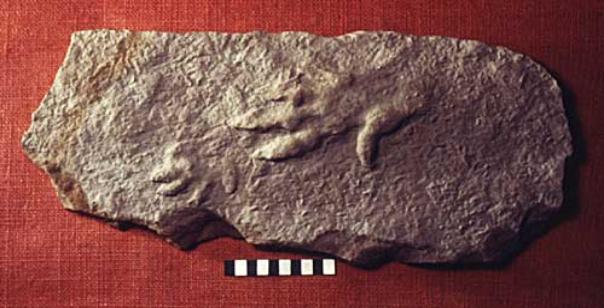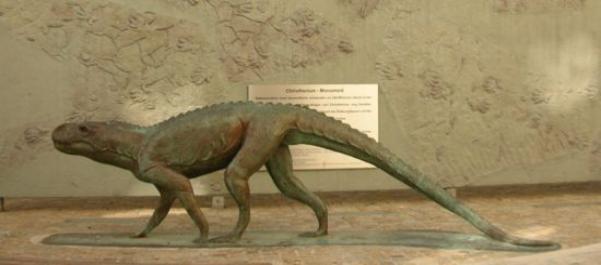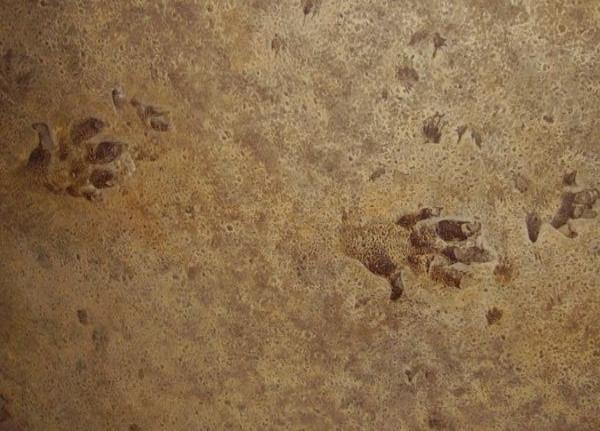

| MENU |

In 1838 men working in Storeton quarry discovered preserved footprints of an unknown
animal. No bones or other material remains were discovered. The Liverpool Natural History
Society, alerted by local architect John Cunningham, helped to preserve a number of footprint
bearing slabs. However, it is also recorded that the workforce at Storeton quarry was also
heavily involved in the findings and preservation. After making the discovery they informed Mr
John Cunningham of their find and then made a substantial effort in determining which
specimens were saved. The quarry owner, the site foreman, and the quarry workmen all
played crucial, if sometimes conflicting, roles in these actions. Eight specimens from the 1838
workings, some with inaccurate attributions, have been traced.
The footprints look like a human hand with a thumb on the outer edge. This led to much
confusion at the time as it was a strange size. Geologists first thought they were the hand
prints of an early ape or human. In 1889 James Howell argued that they were prints from a
large amphibian, but it wasn't until 1925 that Chirotherium was recognised as a reptile. When
the footprints were determined to be of reptilian origin, sandstone was determined to be from
the Triassic period over 200 million years ago. A name was given to this new creature, and
because the footprints resembled human hand prints, the creature was named from the Greek
words, "CHIR" for hand, and THERIUM for beast i.e. CHIROTHERIUM or CHEIROTHERIUM...
meaning "Hand Beast"..
Chirotherium lived in the Triassic period, 225 million years ago. This period was hot and dry all
round the world. Cheshire was a desert with few trees and thunderstorms would create flash
floods and temporary lakes. After rain, tracks in the lakeside mud would be covered with
windblown sand. The sand would have become deeper, then squeezed over millions of years
to form the Triassic sandstone. At least six species of Chirotherium lived in Britain but we still
do not know exactly what the animal looked like. Bones would have been eroded away by the
acidic desert conditions making it difficult to determine the shape. However given modern
techniques we are able to give suggestions of what the creature looked like.
animal. No bones or other material remains were discovered. The Liverpool Natural History
Society, alerted by local architect John Cunningham, helped to preserve a number of footprint
bearing slabs. However, it is also recorded that the workforce at Storeton quarry was also
heavily involved in the findings and preservation. After making the discovery they informed Mr
John Cunningham of their find and then made a substantial effort in determining which
specimens were saved. The quarry owner, the site foreman, and the quarry workmen all
played crucial, if sometimes conflicting, roles in these actions. Eight specimens from the 1838
workings, some with inaccurate attributions, have been traced.
The footprints look like a human hand with a thumb on the outer edge. This led to much
confusion at the time as it was a strange size. Geologists first thought they were the hand
prints of an early ape or human. In 1889 James Howell argued that they were prints from a
large amphibian, but it wasn't until 1925 that Chirotherium was recognised as a reptile. When
the footprints were determined to be of reptilian origin, sandstone was determined to be from
the Triassic period over 200 million years ago. A name was given to this new creature, and
because the footprints resembled human hand prints, the creature was named from the Greek
words, "CHIR" for hand, and THERIUM for beast i.e. CHIROTHERIUM or CHEIROTHERIUM...
meaning "Hand Beast"..
Chirotherium lived in the Triassic period, 225 million years ago. This period was hot and dry all
round the world. Cheshire was a desert with few trees and thunderstorms would create flash
floods and temporary lakes. After rain, tracks in the lakeside mud would be covered with
windblown sand. The sand would have become deeper, then squeezed over millions of years
to form the Triassic sandstone. At least six species of Chirotherium lived in Britain but we still
do not know exactly what the animal looked like. Bones would have been eroded away by the
acidic desert conditions making it difficult to determine the shape. However given modern
techniques we are able to give suggestions of what the creature looked like.


| Footprints from a Cheirotherium |

Footprints of the Triassic reptile Chirotherium, were first described in 1835 from Hessburg,
Germany. Reproductions of these footprints are in display in the World Museum in Liverpool and
the Williamson Art Gallery in Birkenhead. Chirotherium footprints have now been found in
several places in England. They are common in Cheshire's Triassic sandstone and can be seen at
Runcorn, Tarporley, Daresbury, Flaybrick Hill Bidston, Hilbre Island, and Oxton.
Germany. Reproductions of these footprints are in display in the World Museum in Liverpool and
the Williamson Art Gallery in Birkenhead. Chirotherium footprints have now been found in
several places in England. They are common in Cheshire's Triassic sandstone and can be seen at
Runcorn, Tarporley, Daresbury, Flaybrick Hill Bidston, Hilbre Island, and Oxton.
| This is how the Chirotherium is believed to have looked |
| Hand like foot prints of Chirotherium |